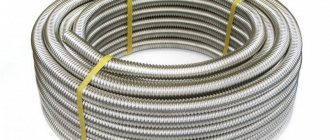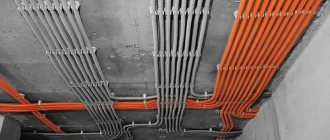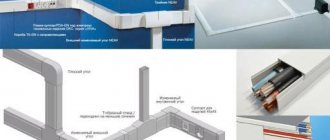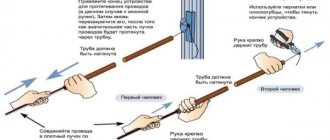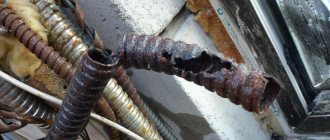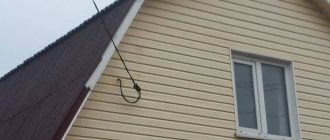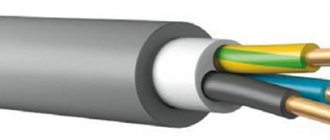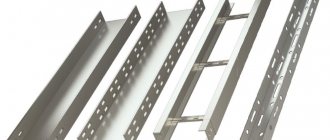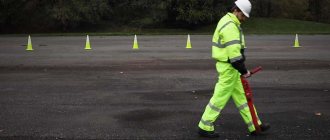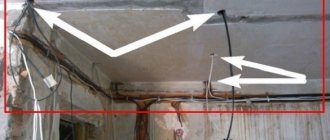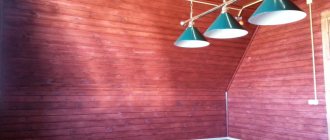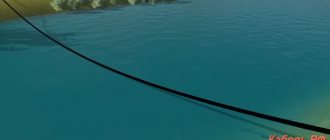Do you want to protect electrical wires by putting a corrugated sleeve on them during installation? Protecting the cable from damage, as well as additional insulation in case of damage to the braid around the cores in home electrical networks, is not superfluous, right?
But you don’t know how to properly install flexible corrugation for electrical wiring, but you don’t want to invite a professional electrician for this work?
We will tell you how to install a corrugated hose - the article highlights the intricacies of its installation, and examines the existing options for such electrical pipes made of different materials with their pros and cons.
The article is equipped with thematic photos, tips on choosing corrugated hoses and video recommendations for laying wires on your own. This will greatly simplify installation and dismantling work.
Why do you need a corrugated hose?
Installing electrical wiring is a responsible matter that does not tolerate mistakes. The safety of staying in electrified premises directly depends on its quality.
The benefits of civilization in the form of glowing light bulbs and numerous household appliances, by definition, cannot work without being connected to the power grid.
And any live electrical cable is a source of damaging current that is dangerous to humans.
It is recommended to use corrugated cables for electrical wires everywhere (for hidden and open installation methods, for installation outdoors and indoors). If this is not possible for aesthetic reasons, then it should be replaced with a decorative cable channel
The first protection against electric shock is the insulating braid of the cable itself. Regardless of the material used, it reliably protects a person from the current flowing through the veins.
However, insulation does not last long. These aluminum or copper wires can last 15–25 years, but the outer braid on them is often damaged within 3–4 years after the wiring is put into operation.
The service life of electrical wire insulation is greatly reduced due to:
- high humidity (outdoor or room);
- overheating under increased loads;
- ultraviolet radiation and other factors.
The result is a breakdown, short circuit, fire and electric shock to a person. To minimize risks, electricians lay wires in a corrugated sleeve.
On the one hand, it serves as an additional barrier between electric current and a person, and on the other hand, it serves as protection for the cable.
If the need arises to replace the old wire in the corrugation, it is simply pulled out of the sleeve, and a new one is inserted in its place - and it does not matter whether this channel is located under the finishing or in a concrete screed
A cable laid in a corrugated pipe receives protection from:
- compression and other mechanical damage;
- ultraviolet radiation and precipitation (when laying wires outdoors);
- exposure to moisture.
And the last thing is fire safety. All corrugated hoses for electrical cables are made of non-flammable or self-extinguishing materials.
This reduces the likelihood of exposure to an open flame on the wire inside the corrugation, and also prevents the spread of fire during short circuits and fires of the plastic cable braid.
Which corrugation is better to choose for the street: PVC or HDPE?
Regardless of where exactly the cable is laid - indoors or outdoors, it is recommended to use plastic corrugated pipes to protect it from external influences. Their main advantage is their resistance to all types of external influences, as well as their low cost and durability.
Using corrugated wire for laying wires outdoors would be an excellent solution. However, it is worth knowing what specific material it should be made of. In this article we will try to answer the question, which is better to choose corrugated material for the street: PVC or HDPE?
Features of the use of PVC
Polyvinyl chloride (PVC) is highly resistant to heat and open flame. However, its significant disadvantage is the presence of a dangerous halogen - chlorine, which, when burned, is released in the form of a caustic suffocating gas. When laying wires externally, this drawback is not so significant, therefore the use of PVC in this area is permitted.
In addition, accessories for protecting electrical wiring made from PVC have a lower price, which is also important for many consumers. Therefore, their use is justified in the case of long wire lengths.
However, among the significant disadvantages of this type of plastic is low resistance to ultraviolet rays, temperature changes and other factors. Due to this, the service life of a corrugated PVC street pipe does not exceed 5–7 years. The only exception is the underground laying of heavy pipelines with increased wall thickness, or laying in concrete. In this case, the period of exposure to temperature fluctuations will be minimal, and ultraviolet rays will not reach the surface of the pipe. Due to this, its service life can be increased to 50 years.
There are also weather-resistant PVC pipelines that belong to the UF series. However, most often it is smooth, rigid products made from this material that are produced, which somewhat limits the scope of application of the pipes.
Features of using HDPE
Low-density polyethylene (HDPE) has fairly high strength and is able to withstand even severe physical stress while maintaining its shape. Thanks to this, HDPE pipes are laid in places where there is a high probability of damage to the electrical main - for example, under garden paths, under a parking lot or driveways.
In addition, this material makes it possible to lay the pipeline in an open way. Accessories made from it, belonging to the UF series, withstand sudden changes in temperature, ultraviolet rays, as well as exposure to moisture and aggressive chemicals of various types on their surface.
However, polyethylene in its pure form provides a very low level of fire safety. Therefore, the installation of a pipeline made of such plastic can only be carried out when laying low-voltage networks - for example, to create decorative garden lighting or to connect fountain pumps.
If you want to lay cables intended for connection to 110–400 Volt networks through protective pipelines, you should pay attention to special series of HDPE products. They are marked FR (flame resistant) or HFR (halogen-free fire resistant). The purpose of electric corrugation for outdoor HDPE is installation on any surface, including flammable and non-flammable. It can be laid in an open way, in the ground or in concrete.
The best option for outdoor use are pipelines of the FRUF and HFRUF series - they have the following advantages:
- Absence of toxic substances in the raw materials;
- Increased fire resistance, resistance to the spread of open flames;
- Resistance to ultraviolet radiation, aggressive chemicals, physical stress;
- Protection against dust and moisture up to IP67.
How to lay a plastic pipe on the street?
If you read materials from specialized forums, you can get a lot of information about the method of laying corrugated pipes outside the premises. The simplest method is underground installation. In this case, a relatively shallow trench is created, the bottom of which is filled with sand, which plays the role of a shock-absorbing cushion. After this, the cable is laid in a plastic pipeline. It is covered with sand on top, after which the ditch is filled with soil, which should be thoroughly compacted.
Laying a corrugated HDPE pipe for the street through monolithic concrete is carried out in a standard way. Pipelines are laid on a prepared base with high-quality waterproofing, after which formwork is formed and cement mortar of the required consistency is poured.
When laid open, pipes are secured with brackets, clips or similar devices. They can be laid on walls vertically and horizontally, as well as on the ground or other flat base. When mounted on walls, pipes may become deformed and sag over time. To avoid this, it is worth stretching a special cable inside them using tension couplings and other types of fasteners. Thanks to this, it is possible to avoid serious deformation of the pipeline during its operation for 10–15 years.
www.220.ru
Types of corrugations for electrical cables
Corrugated hoses for electrical wiring are made from various plastics and metals. There are also composite options made of iron wrapped in a layer of PVC.
It is recommended to choose one sleeve for the street, another for installation in a screed or ground, and a third for installation behind interior cladding.
If the wiring is laid in a dusty room and the channel for it requires a sealed one, then it is best to take a plastic sleeve - the joints between it and distribution panels and boxes are much easier to seal
All corrugations based on strength, wall thickness and design are divided into:
- lightweight (withstand loads up to 320 N/5 cm2) – thin-walled, flexible and fragile, designed for installation under sheathing on ceilings and walls;
- medium (designed for loads up to 750 N/5 cm2) – recommended for installation in wall grooves;
- heavy (withstand up to 1250 N/5 cm2) – thick-walled and rigid, used when installing wires in screeds on the floor;
- super-heavy reinforced (designed for 4000 N/5 cm2 and above) - hoses made of twisted steel wire and plastic sheaths, needed for laying cables underground and on the streets by hanging.
The thinner the walls of the corrugation, the softer and more flexible it is. However, as the flexibility of a corrugated hose increases, its resistance to mechanical damage decreases. At the same time, it is difficult to bend a pipe that is too thick at a right angle; it may simply break.
But such heavy corrugated hoses provide more reliable protection from moisture and dust. This is especially true when laying cables in the ground.
Type #1 - metal hose
When compared to plastics, metal is obviously a more advantageous option in terms of strength. It perfectly protects the cable from chemicals, moisture, ultraviolet radiation, shock and compression. And in the event of a fire, a metal hose will last much longer than its plastic counterpart.
A corrugated metal hose is more fireproof and reliable than its plastic competitor, but it should not be laid in the ground - rust will inevitably do its dirty work
Metal corrugations for laying cables are divided into several types:
- RZ-Ts, RZ-TsKh, RZ-TsA – made of galvanized steel.
- RZ-SL and RZ-SL-X - made of tinned steel tape (tin plated with tin).
- RZ-TsP – with PVC insulation.
The letter “X” in the first two options indicates the presence of a cotton seal, and “A” an asbestos-cement seal. The "P" in the latter type of corrugation indicates the outer layer of PVC.
Also, metal hoses for wires exist with flanges at the ends and welded ends. Plus, there are variations of high pressure hoses in explosion-proof versions and for high pressure.
However, such corrugated pipes are more intended for industrial conditions. They are not used for installing electrical wiring in the house due to their high price and fundamental uselessness.
Conventional metal hoses are made from steel tape by winding it in a spiral. At the same time, the resulting corrugation is not airtight. When pressed firmly, the joints of the tape immediately separate and the sleeve simply falls apart.
The metal hose is ideal for installing electrical wiring in a wooden house and outdoors; here its main advantage (non-flammability) comes in handy
If you need a sealed metal sleeve, you should take a product with additional insulation made of polyvinyl chloride. In this case, the top layer of self-extinguishing plastic will definitely prevent moisture and dust from reaching the steel base.
Only such corrugations are recommended for use in bathrooms and outbuildings, where constant changes in humidity and temperature are the norm.
Type #2 - polyvinyl chloride (PVC)
Gray electrical corrugations made of PVC are characterized by low price and self-extinguishing. In the event of a fire, they not only do not burn, but thanks to the additives in the plastic, they go out on their own.
The main disadvantage of any polyvinyl chloride products is their poor tolerance to UV rays. Under the influence of the sun, this material begins to simply “deteriorate,” which sharply reduces their actual service life.
Corrugated PVC pipes should be used exclusively indoors for wiring electrical wires using hidden technology, laying them behind cladding or other decor.
Another disadvantage of PVC corrugated sheets is their intolerance to low and too high temperatures, as well as excess humidity. When frozen, this plastic becomes brittle. In the cold it is destroyed even from a slight blow.
And in extreme heat (and even if in the sun), the corrugated polyvinyl chloride sleeve begins to soften slightly and “flow”. This does not lead to its immediate destruction or damage, but its service life is sharply reduced due to such operating conditions.
The situation is similar with water. With constant exposure to moisture, the walls of such corrugations begin to gradually collapse.
These PVC pipes for water supply are initially designed for such an impact, but corrugated hoses have slightly different characteristics.
If the wiring needs to be laid in the bathroom or outdoors in direct sunlight, then it is better to look for another cable channel option for it.
Corrugated PVC pipes are ideal for installing wires in dry, heated rooms. They are cheap and flexible, and installation should not be difficult. But their gray appearance frankly does not please with its presentability and aesthetics.
It is best to cover such corrugations on top with finishing (wall panels, plaster with wallpaper on top or clapboard).
Type #3 - polyethylene and polypropylene
Corrugations made from HDPE polyethylene (or LDPE) and PPR polypropylene are approximately equal in cost and characteristics. They are resistant to strong moisture, temperature changes and ultraviolet rays.
Such corrugated sleeves are universal. They can be used both indoors and outdoors.
In many properties, polypropylene and polyethylene are similar, their main difference is that PP cable sleeves are self-extinguishing, while PE sleeves are flammable
Both versions of these electrical corrugated hoses feel comfortable at air temperatures in the range of -40...+45 degrees Celsius. At the same time, HDPE is famous for its resistance to oils, acids and solvents.
It is recommended to use corrugated products made from it in garages, utility rooms and on the streets - that is, anywhere where aggressive technical liquids can get on the wires.
Where are metal corrugated pipes used?
The production of these products was initially mastered in Russia. This happened back in 1875 at a metal factory in St. Petersburg. Then, by 1896, their production was established in the USA. And only then did metal corrugated pipes appear in Japan, Korea and the African continent. In the USSR, serious attention was paid to their production. The older generation remembers the “construction projects of the century” - Transsib BAM and so on. The important role of metal corrugated culverts in this matter is undeniable.
In general, such products present on the modern market differ in diameter and cross-sectional shape. Actually, these parameters determine the scope of their application.
Important! When purchasing a corrugated metal pipe for electrical wiring, remember that the catalog usually indicates the outer diameter. It differs from the internal diameter by several millimeters.
Corrugated pipe products are produced with the following sections:
- round. This section is characteristic of a corrugated metal pipe used to create a culvert structure 1.5-7 meters high. The corrugated pipe for protecting wiring has the same cross-section, but only smaller;
- square. Corrugated pipes with this cross-section are used to create culvert structures and in the construction of tunnels (3-8 meters);
- pear-shaped. Tunnels, culverts (1.5-8 meters);
- arch. For small bridges, road and railway tunnels (height from 2 to 13 meters). Corrugations of this type can be installed in existing embankments by puncturing them;
- pipe-arch. Tunnels under roads and railways (height from 2 to 13 meters);
- vertical ellipse. This cross-section is suitable for telecommunications-type tunnels created on the basis of metal corrugated culverts;
- transition. Pedestrian crossings are built with their use (height 1.8-9 meters);
- horizontal ellipse. This cross-section is inherent in a metal corrugated culvert;
- arch with high or low profile. Small bridges, railway and road tunnels (height 6-15 meters).
Corrugated metal pipes come in different diameters and configurations
Nuances of choosing and installing corrugated channels
Plastic corrugations for cables are available in various colors. Gray ones are usually made of PVC, black ones are made of polyethylene, and blue ones are made of polypropylene.
But there are no strict rules in terms of color. Each manufacturer adds dye to the polymer when making corrugated pipes at its own discretion.
However, there is an international standard for the coloring of such products and the wires in them, which provides for the choice of color in accordance with the purpose of the cable route.
White wires and corrugations are recommended to be used for computer networks, gray and black for general purposes, green for telephone lines, and red - exclusively for external street installation.
Following these recommendations greatly simplifies the life of electricians when they come to carry out repairs in an unfamiliar place. So the direction of each line is immediately clear.
It is strictly forbidden to lay several types of cables with different purposes in one corrugated hose; it is better to use a separate pipe for each wire
Installation of corrugations and electrical wiring in them is carried out in five stages:
- The corrugated sleeve and cable are cut into pieces of the required length.
- Using a cable stocking, a built-in broach, or a wire simply inserted into the pipe, the wire is pulled into the corrugation.
- Sleeves with a cable inside are fixed in a groove, on the floor or wall.
- The laid and secured corrugations are connected to the inlet holes on the bodies of boxes, panels and socket boxes, or simply inserted into them, and the wires are led out.
- Next is the usual electrical installation of devices connected to the electrical network.
To simplify the installation of electrical wiring, you should look for a corrugated hose on sale with a special harness (broach) inside. This is ordinary wire that was pre-strung through a corrugated pipe at the factory.
Only when cutting the corrugation you need to be careful so that this broach does not go inside. The cable on it for pulling into the sleeve is secured using ordinary electrical tape.
You can handle pulling the cable into the corrugated channel even alone, but doing this procedure with two people is much easier.
The metal corrugation must be grounded. And this should be done on both sides of the sleeve.
The internal diameter of the corrugated pipe is selected by doubling the total cross-section of all cables laid in it. This is necessary both to simplify installation and to prevent overheating of the wires inside.
The corrugation must fit flush into the body of the socket, switch or panel. Any “peeking out” of the cable or breaks between the end of the pipe and the body of the installation or distribution device are unacceptable.
In this case, you can forget about protecting the wiring with a corrugated sleeve. Such incorrect installation will only take time and money, it will be of zero use.
Recommendations for installation work
Inserting the cable into the corrugation
The cable is laid in a corrugated pipe using a special string installed by the manufacturer inside the corrugation. The sequence of work when laying an electrical cable in a pipe is as follows:
- The corrugated pipe is stretched over a long straight section. In order to tighten the cable inside the corrugation, you need to have a large space for complete unwinding.
- The end of the electrical cable is connected to the string, the connection point is wrapped with electrical tape for free movement without snagging the wire inside the pipe.
- A minimum of two people are required to complete this work. One person holds the corrugated pipe at one end, the second carefully and without jerking pulls out the string with the electric cable.
- After the cable has appeared on the back side of the corrugation, it is fixed (for example, with electrical tape) on both sides so that it does not jump into the corrugation again.
Fastening corrugated pipes
When installing a corrugated pipe with an electric cable, a variety of fastening methods are used. The most common of them:
- installation using plastic clips: used for installation on any type of structure;
- installation using dowel clamps or dowel pins: used when installing corrugations on concrete and wooden structures;
- installation using plastic ties to a metal cable or frame: used when laying corrugation on the street or in the presence of a metal frame (for example, in plasterboard ceilings);
- installation in grooves with subsequent sealing: used in concrete and brick walls, in plaster.
Conclusions and useful video on the topic
So that you can understand in all the nuances the types of corrugations for low-current and electrical cables, we have made for you a selection of video materials on this topic.
After looking at the reviews and installation descriptions below, you definitely won’t have any questions about the need, types and features of performing electrical installation work using corrugated hoses.
The importance of installing additional insulation on electrical wiring in the form of a special corrugation:
Pulling wires through a corrugated hose in detail:
Overview of different types of electrical installation corrugations:
Cable ducts in the form of corrugated sleeves are extremely easy to install. They are inexpensive, and the benefits of such additional protection for wiring are enormous . The cost of repairs in the event of a fire caused by a short circuit will obviously be higher. Pulling a cable through an electrical installation sleeve looks complicated only at first glance. Everything can be done independently.
Very often, electricians, having made the absolutely right decision to lay the electrical wiring cable in a corrugated area, make many violations and mistakes during this installation.
Let's consider the main ones, as well as common misconceptions associated with corrugation.
The first thing to note is the color of the corrugation. No one ever paints a corrugated sleeve on purpose, except in isolated cases of its decorative use.
Moreover, each color indicates the material from which the product was made.
- gray color is PVC - polyvinyl chloride
To ensure that it looks perfectly smooth and beautiful when mounted on the ceiling, experienced electricians advise buying it not in twisted coils, but in whips.
- black and orange color is HDPE - low-density polyethylene
- blue color PP – self-extinguishing polypropylene
Technical characteristics of PVC, HDPE, PP corrugated pipes:
Many have probably come across beautiful photos and videos where black and orange corrugations spread across the ceiling.
Everything looks beautiful, no doubt about it. And HDPE corrugated material itself, although it costs a little more, is much stronger than PVC. Although it all depends on the brand.
This simplifies its installation and eliminates the possibility of accidental damage. However, such beauty is a ticking time bomb.
The danger is that both orange and black corrugations support combustion very well.
In this case, a fire in an apartment may not start due to a short circuit or overload in the electrical wiring. And now imagine that your entire ceiling is simply covered with such material.
It is enough for one tube to catch fire and the fire will be of such a scale and category that there will be nothing left of the apartment or house.
Your main task will not be to put out the fire, but at least to get out of there safe and sound. And the chances will be slim, given the fiery rain of burning molten polyethylene.
In addition, it is this corrugation that will cause the fire to move from one room to another. In those places where the wiring passes through a concrete wall into another room, the flame can easily penetrate there by spreading the combustion of the HDPE corrugated hose. There will be no problems with PVC.
Because as long as it is exposed to fire, it burns. As soon as the fire is removed, it immediately goes out, because... does not support combustion.
Therefore, gray PVC corrugation should be used in apartments and houses. Multi-colored can be used for embedding into walls and concrete, but not for open laying.
Black HDPE corrugation can and should be used outdoors. Not gray, but colored.
It was created to provide protection from ultraviolet radiation. PVC will crack over time and will not provide protection.
But don’t listen to all sorts of stories from installers that it’s ideal to use colored marks to wire low current and power circuits.
For the installer, this may be convenient during the work process, but you will have to live with this fire-hazardous material for the rest of your days.
Non-standard cases
The first and most common situation is when the string is pulled away from the conductor due to strong tension. In this case, it is recommended to cut off the part of the corrugation that has already been threaded and leave it, then reconnect the wire to the end of the cable and finish pulling. The two pieces of corrugated pipe are then connected with electrical tape.
Pulling the wire through the corrugation, if there is no broach, is also not difficult. It is enough to simply bend the end of the conductor 180° and insulate it so that it does not cling inside the pipe, and then push the product through the entire required length. This technology is clearly demonstrated in the video below:
How to start a wire without a probe
If you have little space in your apartment and you need to thread a long section of corrugated pipe yourself, for example, 30 meters, it is not always possible to do this in a room without experience. In this case, it is recommended to first connect the cable to the string, then go out into the entrance and secure the free end of the wire to the railing on the top floor. After this, stretch the corrugation until the problem is solved. Or use the Health disk as shown in the following video (second minute):
Sometimes it becomes necessary to stretch a conductor in a corrugated pipe along the ceiling, or rather inside a suspended plasterboard structure. This is quite difficult to do, because... if the sheets are already sewn up, installation must be done through grooves under the lamps. In this case, a regular string will help to insert the corrugated pipe through the ceiling. In the video tutorial, the masters clearly demonstrated the essence of the work:
How to lay a corrugated hose through a plasterboard ceiling
Well, the last situation that I would like to describe is laying a cable with rubber insulation in a corrugated area. The difficulty lies in the fact that when pulling, strong friction occurs between the walls of the corrugated pipe and the insulation of the conductor. As a result, even the wire does not facilitate the process, and if there is no broaching, in this case it is generally unrealistically difficult to complete the installation. A special lubricant comes to the rescue, for example Wire Pulling Lubricant from 3M, with which you can quickly pull the cable through a corrugated pipe. The cost of such a lubricant is a little high, however, if you often perform electrical installation work, we recommend purchasing it, because One bottle lasts a long time.
That's all the information we wanted to provide
Please note that it is better to tighten a cable with a cross-section of 3*1.5 mm2 into a pipe with a diameter of 16 mm. At the same time, for a section of 3 * 2.5 mm2, a diameter of 20 mm is needed
Now you know how to pull the cable into the corrugation with your own hands and what to do if there is no pull!
It will be interesting to read:
- How to conduct electrical wiring in a wooden house
- Electrician tool set
- Methods for attaching the cable to the wall
"Fire-fighting" properties of corrugation
Another common misconception is that corrugation is believed to have fire-fighting properties. Very often you can encounter a situation where corrugation is laid on combustible bases behind suspended ceilings.
Or they are even used instead of a steel pipe for hidden installation of electrical wiring in wooden houses.
Do not forget that the corrugated tube is designed to protect the cable from external influences, but does not have any localization ability. In case of short circuits, no corrugation or even a metal hose can save you. The fire will find a way out.
Here is a visual test of plastic corrugated hoses, not with an open flame, as everyone else does, but with hot wire. That is, when the cable is not yet on fire, but has only become as hot as possible due to overloads or a short circuit:
The question is, how will such “protection” save your wooden structures in the event of a circuit breaker failure?
Hidden electrical wiring on combustible substrates must be laid in a steel pipe with localization ability, or using a layer of non-combustible material such as gypsum plasterboard, using false walls.
Some people wonder, where can a short circuit in the middle of the cable come from? There are most often two reasons:
- rodents
- manufacturing defects
While a metal hose can somehow save you from rodents, it won’t protect you from manufacturing defects.
If you think that by laying all the wiring in the corrugation you can easily and simply change it if necessary in the future, then you are again mistaken.
Here we can talk about replacement only for cables on absolutely flat areas. For example, in a straight line from one junction box to another, or a descent from the junction box under the ceiling to the socket box below.
Once you take at least one turn at an angle of 90 degrees on the highway, replacing the wiring will turn into a complete torment. And if there are two turns, then simply forget about such a thing as turnover.
It doesn’t even matter that this will be a minimum distance of 2 to 2.5 meters. A high-quality cable is so rigid that even with a corrugation diameter of 20mm it will be practically impossible to do this.
You may need such force that the cable will pull itself out along with the corrugation from under the layer of plaster. Those who, instead of VVGng, use multi-core flexible wires of the PVS type and say that everything changes and stretches wonderfully, simply violate all current standards and rules.
Under no circumstances should you listen seriously to such advice.
Increased cost of work
Let's figure out whether corrugated installation really leads to a significant increase in the cost of repairs.
For ease of installation of electrical wiring, many use round NYM cable, including VVGng with a round cross-section. At the same time, they tighten it into the corrugation d=16mm.
After which you need to prepare a 20mm*20mm groove. If you have a wall chaser, the width of the groove when installing the disks does not particularly affect labor costs.
Many people initially set the cutting depth to 25mm to make it easier to cut the middle of the furrow. The shallower the cutting depth, the harder the core chips.
Therefore, in order to lay the bare cable in the groove, you will still have to cut a strip approximately 20mm deep. Or work very hard with a hammer drill, which will ultimately lead to no less labor costs.
At the same time, do not forget one important nuance - gating in load-bearing walls in panel houses and hollow-core slabs is prohibited.
And where the cutout is not made in load-bearing walls, firstly, the integrity of the reinforcement should not be compromised, and secondly, the depth of the cutout should not exceed 20mm.
Therefore, when we talk about cutting a groove in a wall, in 90% of cases we mean cutting a groove in the plaster. The problem is that not everyone wants to apply 2.0-2.5 cm of mixture to the walls, just because of the wiring.
However, there is still an increase in cost when working with corrugation, and for many it can be critical. When working with this material you need:
- special fasteners and nails
Using a mounting gun, on average it takes 3 shots per 1 meter of corrugation.
If you use boxes with 4 separate inputs, then without corrugation you can place a much larger number of cables there. But when working with corrugation, there are only four!
Therefore, the total number of boxes, although not significant, will increase.
It was already said above that the gating itself does not increase costs so significantly, but if we talk about drilling through holes through the walls, then everything can change significantly.
If you drill one hole d=32mm, you can easily pass 4 bare cable lines through it. But for the same quantity, but already in a corrugation, you will need to drill at least 4 holes.
When working in an apartment with soft partitions, this point is not critical. But if you try this in a private house, or in a panel high-rise building with high-quality concrete walls, your labor costs will increase many times over.
For many electricians working alone, it can take a whole day of work just to punch through holes.
Therefore, yes, in some cases, depending on the working conditions and the specific object, the increase in the cost of laying cables in corrugated cables can be at least 30%. And for some, this is a significant difference in the total cost of repairs.
But can corrugation, on the contrary, help save a lot? Surprisingly yes.
Here is a very original use of it for securing a cable in a groove. Thanks to it, you can completely eliminate the cost of dowel clamps.
In this case, you can even use the remains of corrugated hoses, which are no longer needed anywhere.
Installation of corrugated pipes
For external (open) installation, special plastic clips are used to secure the corrugations for cables and wires, which are selected to match the outer diameter of the pipe. The clips are attached every 20-30 cm with self-tapping screws or dowels, depending on the type of wall. The corrugation for the kbaley is inserted into the installed clips and pressed until it clicks. When installed in a groove, it is secured with plastic ties or dowel ties. You can also use homemade fasteners - strips of tin with nails or screws in the middle.
When developing a route, the following recommendations should be taken into account. They assume that the route should be without sharp turns so that, if necessary, a new piece of cable can be tightened. Because:
- The maximum possible length of the section is 20-25 meters. Provided that the track has no more than 4 turns.
Lay the electric corrugation in parallel, trying to make as few turns as possible - Turns should not be located next to each other. The distance between them is at least 4-5 meters. If there is a need to make turns nearby, it is better to place a junction box or inspection hatch near them.
- The rotation angle is at least 90°, the radius is larger, the better.
- If the routes for electrical wiring and low-current cables and wires run side by side, the minimum distance for laying two corrugated sleeves is 200 mm. They can only intersect at right angles.
These rules apply to the development of routes for ground (suspension) and underground cable laying, among other things. If the route is long, and you want to be able to re-tighten the cable “if something happens” without replacing the corrugation, design the route taking these rules into account.
Corrugated wiring installation
When installing wiring in a house or apartment, pieces of corrugation are secured between distribution boxes, from them to switches/sockets, and to lighting fixtures. The sections here are usually small, straight, with a maximum of one or two turns. So there are no problems with cable tightening.
If you need to tighten several conductors into a cable corrugation, they are folded and secured along the entire length with adhesive tape or electrical tape in increments of 30-50 cm (depending on the rigidity). Hard insulation is stripped off 10-15 cm from one edge, the wires are twisted into a common bundle, and a loop is formed from it (also secure the loop with tape or tape). If the rope turns out to be too thick, you can form loops separately, just stretch the twine through everything. A cable is tied to this loop, and then they begin to pull it from the opposite side, pulling the sheath over the cables. In this case, you must pull without jerking, smoothly, so as not to damage the cable or cable.
How to pull a cable into a corrugation
During installation, be careful not to let the broach slip out. To be sure, you can secure the cable with a piece of tape. There are two installation approaches:
- First secure the corrugation, then tighten the cable or wires into the finished piece.
- First stretch the cable, then install it.
The first method is good when installing internal wiring, where the distances are small - from box to box, from box to outlet, etc. The second method is more suitable when installing long sections.
Features of open installation on the street
When laying wiring outdoors, it is usually suspended on a cable. For outdoor use, a metal one made of stainless steel is suitable, or better yet a metal-polymer corrugation for the cable, as well as a plastic one made of polyamide (black or blue). All these materials are UV resistant and remain flexible at sub-zero temperatures.
Although this is a cheap method, it is not the best, since the ties will burst
During installation, the cable pulled into the corrugation is suspended on a cable. The cheapest fastening is ordinary plastic ties. There are also special hangers.
Errors and rules for installing corrugated cables
- do not create sharp corners when designing routes
- To increase the length of a single piece of corrugated tube, use special transit boxes, tees and couplings
Do not connect the tubes to each other using electrical tape. Install connecting accessories at turns, corners and closer to the middle of the entire area.
- You cannot stretch several cable lines in one corrugation at once
- power networks and low current must be separated from each other, maintaining appropriate distances
- if you are not running a cable in a corrugated pipe, but individual wires, here is a table for selecting the maximum cross-section of conductors and their number, depending on the diameter of the tube:
Recommended corrugation diameters for different networks:
- Corrugation d=16mm is usually used on the lighting line
- for power sockets with a diameter of at least 20mm
- for coaxial cable for video surveillance – no less than 25mm
- for low current (telephone, internet, TV cable, alarm) D=16mm
Corrugation for wires and cables provides excellent protection against damage. This device will be needed when pulling cables underground or when conducting electrical wiring inside a building. Corrugated pipe is an important attribute of any hidden wiring. We will tell you how to choose it wisely in this article.
The safety of the entire building depends on the quality of such products.
Manufacturing and advantages
The strength of metal corrugated pipe for electrical wiring is due to its variable cross-section. Assembly is carried out from standard elements in the factory. For this, corrugated metal sheets are used. They are connected to each other using plano-concave and plano-convex washers using bolts. The standard size of all these elements is determined by the dimensions of the structure. Hot-dip galvanization provides high corrosion resistance. A metal corner is used for edging. During the manufacturing process of the structure, a grade of steel is used that is optimally suited to the expected operating conditions:
- 15SP – from minus 40˚С and above;
- 09G2D – at minus 40˚С and below.
The production of corrugated stainless steel pipes has its own characteristics. For the first time, such material was used for this purpose in the early 80s of the last century in Japan. The manufacturing process uses steel tape with a thickness of 0.25-0.3 millimeters. The formation of pipes from the tape is carried out by argon welding on an automatic line. The reliability of the weld is monitored using a laser system. Its width should not exceed the wall thickness by more than 1.6 times. The formation of corrugation is the final stage of production of products of this type.
Helpful information! Before sending finished products to the warehouse, corrugated pipes for wiring must be checked for leaks by immersion in a container with ordinary water. Compressed air passed through the product localizes defective areas.
In addition to performing the functions of protecting wiring from negative influences, metal corrugated pipes are widely used in heating and water supply systems.
Pipe production includes several stages, the formation of corrugations is the final part of the process
The advantages of stainless steel products include:
- ease of installation and operation;
- increased heat transfer (compared to copper);
- impossibility of formation of sedimentary deposits on the walls;
- high corrosion resistance;
- Possibility of use in the temperature range 0≤ T≤ +100˚C.
- ability to withstand pressure up to 65 bar (64.15 atmospheres). If welding is performed at a temperature of about +1150˚С, the seam can withstand 210 atmospheres.
Corrugation for wires: design and materials
Corrugated pipe for cable is used for installation of all kinds of lines, as well as for various wiring options: disguised, underground and external. They differ in their design, technology and raw materials.
The following types of materials can be used:
- HDPE is a flexible wire;
Application of HDPE material
- polyvinyl chloride is a self-extinguishing type of raw material;
- pnd is used for hidden lines. It is laid in concrete structures or bricks;
- polypropylene is a plastic line that is used to install the cable;
- polyamide provides good waterproofing.
Structure of a polyamide product
If the wiring is laid over flammable types of material, then heat-resistant metal corrugation is used. Pipes can have different designs. In the single-layer version, the main has one wall between the outer and inner surfaces. A two-layer product has an inner layer that is placed in a protective casing.
Corrugated wires are in demand due to many advantages:
- long service life;
- does not allow moisture to pass through;
- fire resistance;
- increased resistance to various types of load;
- does not corrode;
- light weight.
Operating principle of the protective product
One of the main characteristics of all tubular products is resistance to external mechanical loads of any origin. These primarily include the weight of the soil. If you compare a corrugated and smooth-walled metal pipe, it becomes obvious that with equal nominal diameter, the surface area of the former is much larger. And from a high school physics course we know that
P=F/S,
where P is pressure, F is force acting perpendicular to the plane, S is surface area.
Analysis of this formula shows that the larger the surface area, the less pressure is applied to each square centimeter of a corrugated metal pipe. This factor provides significant load-bearing capacity of this product.
Helpful information! The walls of the pipes transfer part of the vertical load to the surrounding soil. Therefore, the primary role is played by how well the soil or concrete mixture adheres to the surface of the corrugated pipe over the entire cross-section.
If, when laying these products, voids are left on the sides, the probability of deformation of these structural elements is non-zero.
The strength of corrugated pipes is higher than that of smooth ones, so they are used for underground pipelines
Why are corrugated metal pipes for electrical wiring so popular?
The main purpose of metal corrugation for wiring is to protect wires from various damages. In residential premises, metal corrugated cables are used for cables that are routed over combustible surfaces. These are various electrical wiring above suspended structures, in outbuildings and wooden buildings.
Additional protection is important when the cable comes into contact with pipelines. This is important when crossing heating lines and gas pipelines. Laying electrical wiring inside a metal case is done in several steps:
- the wires are pulled inside the protecting line;
- installation of structures on surfaces and supply of wires to panel boxes;
- connecting cables.
The protective line is laid over various surfaces using clips. It is necessary to fasten at distances to prevent sagging. Pay attention to the installation of cables and wires inside electrical appliances. Condensation should not collect in the corrugation. When inserting electrical panels into structures, various couplings are used. Fittings are used to connect elements.
Application of metal lines for industrial purposes
Metal differs from similar options in increased strength. The following options are also available:
- plastic corrugation has excellent technical characteristics;
- the outdoor version is used for wiring outside, it is resistant to aggressive environmental conditions;
- Automotive pipe is used to preserve wires in cars;
- the product for pulling cables in the ground is wear-resistant and can be used for a very long time;
- Modern options include PVC construction;
- The heat-resistant version has an increased level of strength and is not subject to thermal effects.
Cable laying in the garage
Number of layers and resistance to external influences
Plastic sleeves can be single-layered of different thicknesses or double-layered, with an additional protective jacket.
The use of corrugated PVC hoses should not be allowed in places where aggressive substances are present:
- solvents;
- petroleum products;
- aldehydes, etc.
Such compounds almost always exist in the soil of large populated areas.
Therefore, for laying in the ground, it is better to use aluminum or HDPE corrugation.
How to work correctly with corrugated pipe?
It is difficult for beginners to understand how to correctly route a wire through a corrugated pipe for electrical wiring. Although there is nothing complicated about this, you just need to follow certain steps:
- the required length is measured locally and cut, and then the wire is cut with side cutters;
- you need to hold the broach so that it does not get lost in the pipe;
- a tourniquet is made, which should be tight;
- the harness inserted into the corrugation must be attached to a metal broach;
- The joint areas are wrapped with electrical tape.
After placing the wiring, the corrugated pipe is fixed every 20 cm with special fasteners. The clamps are first attached to the corrugation, and then to the surface. A special device is used to pull the cable through the corrugation.
Stainless steel corrugation
How to insert a wire into a hose
Correct connection of the string with the wire installed in the corrugation
It is recommended that two people work together. This is due to the algorithm of actions.
- Remove the end of the wire (a kind of cable or string) from the hose and connect it to the cable being installed. A hole is made in the wire winding, a thin wire is pushed through it and securely fixed by twisting.
- The hose is leveled along its entire length, only after this can you begin to wind the cable into the corrugation.
- One worker firmly holds the end of the pipe from which the cable is wound, and the second pulls the wire from the other side. This approach allows the wire to be pushed through efficiently.
- The fully extended wire must be wound to the pipe to prevent the structures from moving relative to each other.
What to consider when choosing a corrugated pipe
When choosing corrugations for wires, you need to consider some recommendations. Pay attention to the color scheme of the material. It is better to choose a color that is uniform and without inclusions. Since heterogeneity indicates that the product is made from recycled plastic.
To make the installation process easier, do not save too much and choose a tube without broaching. This is important for small diameter pipes.
Installation of multiple wiring
When purchasing accessories, do not forget about special fasteners for installing pipes. In this case, you can use clamps, clips and dowels.
Various types of cables are used in corrugated electrical wiring, so it is important to choose the correct sizes, which depend on the cross-section of the wires. For computer lines, a pipe with a cross-section of 16 mm is suitable, and for connections to sockets, a pipe of 20 mm is used. For power structures, pipes with a diameter of 25-55 mm are suitable.
Electrical wiring diagram option
In the table you can see how to choose corrugation taking into account the color scheme.
| White | For computer wires. |
| Grey | For any electrical wiring lines. |
| Black or brown | For various household units. |
| Green | For telephone lines |
| Red | For wires outside the building. |
| Blue | For underfloor heating structures and for water supply lines. |
| Yellow | Gas supply. |
According to fire safety, this material is divided into three categories:
- for installation on non-flammable surfaces made of concrete or brick, any pipes are used;
- LDPE and PVC corrugation are used in frame buildings;
- For installation in flammable structures, fire-resistant pipes are used. The use of plastic on such surfaces is prohibited.
Price of metal corrugation for cable
The average price for a corrugated meter cable varies from 10 to 800 rubles. The cost of a metal pipe will be higher.
In the table you can see the price for specific corrugation models.
The diagram shows the installation of a corrugated pipe using special fasteners
Which manufacturers are trustworthy?
Do not buy openly “no-name” corrugation, as practice has shown that the stated characteristics often do not correspond to reality. Of the manufacturers that deserve trust, we note the following:
- DKC;
- I.E.K.;
- EKF;
- KOPOS;
- ERA;
- Ekoplast;
- RUVINYL;
- NASHORN - so far only PVC corrugation is in stock.
Their components are of course more expensive than their Chinese counterparts, but the quality is many times better. Moreover, there are no problems buying in Russia.
Some more interesting things from the world of electrical engineering:
- Why is there 220 V between phase and zero, and 380 V between phases?
- Why is the voltage in the US 110 V, and in Russia 220 V?
Useful tips
To create safe and durable wiring when choosing a corrugated pipe and its installation, follow our tips:
- If possible, do not use sharp corners;
- when used in long networks, connect pieces of corrugation using transit boxes;
- in monolithic structures, the corrugation is installed before pouring, and the wiring is pulled after hardening;
- when carrying out hidden wiring, grooves are made in advance where the pipe will be laid;
- external wiring is hidden behind suspended or plasterboard ceilings.
Pulling wires under the roof
If you follow all the recommendations, you will be able to choose the appropriate corrugation option and make the correct installation of all electrical wiring.
Criterias of choice
When choosing a pipe, you need to take into account that it fits the plumbing fixtures installed in the room. First of all, the diameter corresponding to home communications is selected. The cross-section of the pipes also plays a role. It must be suitable for the power of the devices. The grade of steel used in production is also important.
You need to understand that manufactured products come in two types: annealed and unannealed. Using the former, the heating system is installed, and connecting elements are made from unannealed ones.
There is one more criterion that people pay attention to when choosing - design. This determines what operating pressure the system can withstand.
High-quality corrugated products have the following parameters:
- The maximum permissible pressure is 50 bar.
- The kit includes connecting elements.
- Withstands temperatures from -50° C to +110° C.
- They have a small degree of elongation (2% of the total length).
As you can see, there is no need to take into account many complex features.
